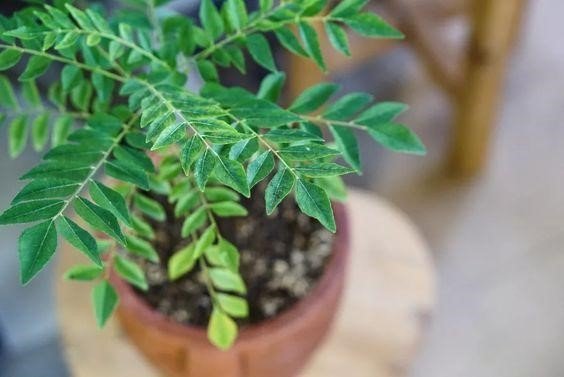Originating in the Indian subcontinent, Curry Tree or Murraya koenigii is one of the easiest and fastest growing trees.
The fragrant and flavorful curry tree
It may grow up to 15’ tall with pinnate leaves that are an important ingredient in many culinary dishes, especially in South India. Besides the visual aesthetics that it offers to your food, the curry tree leaves have an aromatic flavour that helps make your meals tastier. Also, the leaves have several therapeutic properties. These are said to reduce stress and help heal wounds and burns. The curry leaves are also said to promote healthy eyesight.
See also: Parsley leaves: A culinary blessing in your garden
Curry tree: Quick facts
| Name of species | Curry Tree |
| Scientific name | Murraya koenigii |
| Height | 6-20 feet |
| Family name | Rutaceae |
| Distribution range | India and recently, some parts of Australia |
| Best time to grow | Spring or summer |
| Benefits and uses | Culinary ingredient, promotes eyesight, reduce stress, heal wounds, treat digestive issues |
| Care and maintenance |
|
Curry tree: Description
The curry tree can be grown both in the ground and in containers. However, as the fully-grown tree may attain a height of up to 20 feet, it is recommended to move the young plant to the ground after some time. Still, if you live in an apartment that does not have the luxury of a backyard or front garden, no worries. You can easily grow your favourite curry tree in a pot under certain conditions. Scroll on for all the necessary information.
Curry tree: Varieties
First of all, you should choose the exact variety of plants you want to grow. There are three main varieties, namely:
- The regular: Leaves of these trees do not have any fragrance, and the plant grows pretty fast.
- The dwarf one: These plants are short but have long leaves that, again, have less or no fragrance.
- Gamthi: The leaves of this tree exude a beautiful fragrance, but the tree itself is not a fast grower. However, it grows pretty tall and has short leaves.
From seed to spice: Cultivating a curry tree
Curry leaves can be grown from seeds but they better grow by propagation. Growing curry leaves with the help of seeds may take very long for the plant to germinate, grow and finally harvest.
Growing your own curry tree at home
If you are planning to grow a curry tree in your home garden, you should know all about its needs and requirements for growth, starting from the type of container it will thrive in to its watering needs.
Type of container

Source: Pinterest
While growing a curry tree in a pot, you should choose a medium to large-sized container having an open, wide mouth. If you do not get such a container, use an empty bucket that will serve the purpose quite well. However, make sure that the container has drainage holes at the bottom. If you choose a plastic or clay pot, at least two to three drainage holes should be there.
Soil requirements
Fill the container with a well-draining, high-quality potting mix that is slightly acidic. Add a considerable amount of organic manure or compost to enhance the growth of the plant. Plant the saplings in the potting mix and water regularly. Keep the container in a spot that receives adequate sunlight, and do not pluck the leaves before ten months.
Light requirements
The curry tree fares well in full sunlight. So make sure that you place the container in an area that receives full sun during the day. Choose the sunniest spot on your balcony or terrace to help the plant grow fast.
Water requirements
During the growth phase, you may need to water the plant at least once every two to four days. That is about two months after planting. However, you should let the soil get dry after a heavy shower or during the monsoon and avoid overwatering. Once the plants are about two months old, moderate watering will do the job. Do not overwater during winter, and feel the soil before you do it.
Fertiliser requirements
The curry tree requires nitrogen-rich fertilisers to grow well and develop beautiful foliage. However, you need to add organic compost while planting the saplings, as it helps accelerate growth. You can also add liquid fertiliser to the soil to ensure healthy foliage. Iron sulphate or iron chelate is considered beneficial for the growth of healthy leaves. If you are into natural fertilisers, buttermilk can be used.
Read the instructions on the label of the fertiliser you are about to add to the plant. One more thing to remember is to avoid fertilising the plant during the winter season, as it attains dormancy then.
Temperature and humidity
Now, the curry tree is essentially a tropical plant that does not thrive well during the colder months of the year. Although it may tolerate mild frost, the plant doesn’t do well in icy areas. It sheds its leaves and then goes into dormancy. Do not water or fertilise the plant, then. It will thrive in spring, and you can start caring for it again.
Curry tree: Care and maintenance

Source: Pinterest
A curry tree does not require too much maintenance. Just take care of a few things:
- If the temperatures go below 32F, bring your curry tree indoors, or it will die.
- Do not over-water the curry tree. In spring, water it every week, and in summer, make it once every two to four days. In fall/autumn, water the plant again every week, and in winter, do not water it more than once in three to four weeks.
- Do not prune the leaves in summer, and in autumn, do it only if necessary. And again, do not prune the leaves in winter.
- Fertilise the tree only in spring and summer. Do not fertilise it in any other season.
- If you need to transplant the curry tree, do it only in spring, and move the plant to a larger container. Water it thoroughly after replenishing the soil and add fertilisers if needed.
Caring tips during winter

Source: Pinterest
As mentioned earlier, the curry tree does not do well in cold temperatures. If you are growing the plant in a pot, keep it indoors, in a warmer spot during winters. But if you have planted the tree in the ground, cover it up from top to toe with a garbage bag, as it will help protect the plant from the chills. Otherwise, the leaves may turn yellow and ultimately fall off.
Curry tree: Repotting
This is again applicable if you are growing the plant in a container. Repotting should be done every two years, as the roots of a curry tree are extensive and may outgrow the container. Before you plant the tree into a new container, make sure you cut off the dead and old roots. Prepare a good potting mix in the new container and place the place carefully into it. Do not forget to water it well to help the tree grow spontaneously in its new home.
Cooking with fresh curry leaves
Cooking with fresh curry leaves add an aromatic and a distinct flavor to your dishes. Fresh curry leaves are cooked and had in most households as they hold great health benefits.
Curry tree: A must-have for Indian cuisine
These are a must have in South Indian cuisine. They are used by shallow frying them in oil or ghee along with mustard seeds and hing powder. They are used as a flavour enhancer in curries, soups, rice dishes, and chutneys.
Curry tree: Uses
The curry tree leaves have amazing therapeutic and other benefits. They can be used in culinary preparations to enhance the taste, as well as add some nutritional benefits. Some of these benefits have been mentioned below:
- Anti-cancerous: The flavonoids present in curry leaves have anti-mutagenic properties, thus helping in preventing certain forms of cancer, like breast cancer, cervical cancers and even colon cancers.
- Antioxidants: The curry leaves are sources of powerful antioxidants that protect our body from the immense damage caused by free radicals.
- Anti-diabetic: The leaves are said to help reduce sugar levels in the blood and are thus considered extremely beneficial for diabetics. Also, the curry leaves promote the activity of insulin in the body.
- Prevent heart diseases: Consuming curry leaves helps reduce the risk of developing heart diseases, as the chemicals in the leaves reduce the levels of bad cholesterol in the body. Also, these are powerful antioxidants that prevent the heart and other organs from oxidative damage.
- Hair care: When boiled with coconut oil, the curry leaves are said to reduce hair fall and dandruff in many cases.
- Promotes vision: The curry leaves are rich sources of vitamin A, which is good for our eyes. Consuming the leaves is also said to prevent or slow down the development of cataracts in senior citizens.
Curry tree: Toxicity
It is advised by medical practitioners to pregnant and breastfeeding women not to consume curry leaves, as they can be toxic to them. Also, one should not consume the leaves if they are allergic to them. Consulting your physician before starting to consume the leaves is highly recommended.
FAQs
Can I grow a curry tree from seeds instead of saplings?
The seeds of a curry tree have a slower growth rate as compared to saplings. You may not be able to harvest the leaves before two years if you grow the plant from seeds. So, it is better to plant saplings.
Does a curry tree always require full summer sun?
It requires full sun, but in hot and humid regions, it is recommended not to place it in direct sunlight. Instead, you should keep it in a partially-shaded spot, especially if the temperatures rise above 100 F.
What kind of soil does the tree need?
It requires well-draining, organically-rich, slightly acidic soil. Maintain the pH of the soil between 5.6 and 6.0 for maximum results.
What are the benefits of a curry tree?
The leaves can be used in several culinary delights, like soups and curries. Their citrus-like essence and flavour add to the taste of the food, as well as makes it visually appealing. Besides, consuming the leaves in food is said to have some health benefits as well. For example, the leaves help reduce stress and treat digestive disorders. They are also said to promote eyesight.
Housing News Desk is the news desk of leading online real estate portal, Housing.com. Housing News Desk focuses on a variety of topics such as real estate laws, taxes, current news, property trends, home loans, rentals, décor, green homes, home improvement, etc. The main objective of the news desk, is to cover the real estate sector from the perspective of providing information that is useful to the end-user.
Facebook: https://www.facebook.com/housing.com/
Twitter: https://twitter.com/Housing
Email: [email protected]











